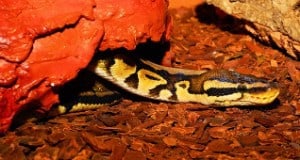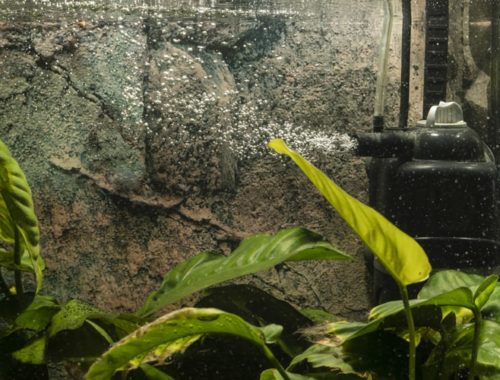Are you thinking about getting a snake for a pet? If you have never owned a snake before, a ball python is a good choice. They are fairly small and docile, and this type of snake is easy to take care of. On average, they will live 20 to 40 years, so be sure you are ready to make a long-term commitment to your new pet. Read on to find out how to take care of your ball python so the two of you can enjoy the next few decades together.
How to Set Up for Your Ball Python

- Buy a 30-gallon or larger aquarium. Even if your snake is small right now, he will grow and will need room to move around, hide, choose different areas to be in, and so on, so you will want a nice, large aquarium for your pet. Make sure it has a mesh top so he can’t escape.
- Purchase a heat lamp and two thermometers. Your ball python will need a hot spot for basking; this area should be 90 to 95 degrees. Use a heat lamp to keep one area warm (but not too hot). He will also need a cooler spot, which should be between 75 and 80 degrees. It is important that you know the actual temperature on both ends of the aquarium, so place a thermometer in both locations and monitor it daily.
- Give your snake two hiding places. Ball pythons like to hide, so it is important to set up areas for him to hide in the hot area and the cooler area. You can purchase commercial hiding boxes or you can use a terracotta flower pot or something similar.
- Line the bottom of the aquarium with something like shredded newspaper or moss. Don’t use pine or aspen shavings, because these will absorb too much humidity and make it too dry for your snake.
- Include a soaking tub. Your snake will sometimes want to take a dip, so his water dish should be large enough to accommodate him soaking for a bit. Look for a dish that is shallow; young snakes should have only about an inch of water to prevent drowning.
How to Feed Your Ball Python
- Feed your snake a rodent every week or two. Ball pythons eat every 7 to 14 days or so, sometimes less often in the winter. Younger snakes need to eat every week, most of the time, and older snakes will often go two weeks in between feedings. The rodent should not be wider than your snake is at her widest point. You will need to thaw a frozen rodent or pre-kill a live rodent. Do not give your snake a live rodent because there’s a good chance your snake will get hurt.
- Simply place the rodent in the snake’s habitat and wait. If your pet is not interested, remove the rodent after an hour or so. For a young snake during the warmer months, you can try again the next day. For an older snake or during the winter, wait several days to one week before trying again.
- Don’t handle your snake for at least one full day after feeding her. This is because handling too soon can cause her to vomit.
- Expect that your snake might skip feedings in the winter. This is common, particularly for adult snakes. Simply offer her a rodent every few days or once per week. When she is ready, she will resume eating normally.
- Make sure she has clean, fresh water at all times. Keep in mind that she might soak in her water dish, so you will probably need to change the water daily. The water should be a bit warm, between 100 and 104 degrees. Change it immediately if she defecates in the water.
How to Hold Your Ball Python
- Be patient. Many ball pythons are shy and fearful at first. If your snake is hiding from you, give him time to get to know you before you try to handle him. You might get bitten the first few times that you try to pick him up if he is particularly fearful. If this happens, wash the bite with soap and water, and don’t attempt to pick him up again for a few days.
- Carefully scoop up your ball python using both hands. Support his entire body to help him feel more secure. Don’t move quickly; keep all of your motions slow and gradual while you are holding him.
- Sit down and relax while you’re holding him. This will help you stay still and will help your snake feel more comfortable.
- Don’t handle your snake the day you intend to feed him. Many snakes will feel stressed and won’t eat after being handled. Also, don’t handle your snake for a full day after feeding him because it could cause him to regurgitate.
How to Clean Your Ball Python
- Your ball python will probably bathe herself. If you have a large, shallow water dish in her aquarium, she will likely take the opportunity to take a soak now and then. In this case, you don’t have to do anything to bathe your snake.
- You can place her in a shallow container of water. If your pet isn’t bathing herself, then a bath when she is shedding will help remove dead skin and keep her more comfortable. Use warm water (100 to 104 degrees) in a container that will accommodate her whole body. Only use about an inch of water. Let her soak for 10 minutes or so, then take her out.
- Place her in a holding cage. If you have a spare aquarium or cage, it is a good idea to put her there for a short period of time. Many snakes defecate after a bath, so this will allow her to do so without messing up her aquarium.
- Provide something for her to rub against during her molting period. Placing pine cones, some small tree branches, or stones will allow your snake to rub off her dead skin. If she is trying to rub against the smooth sides of her tank, that is a sign that she needs something coarse to help her remove the old skin.
How to Clean Your Ball Python’s Habitat
- Spot-clean your snake’s tank daily. Remove any wet bedding or feces every day. Your ball python will normally only defecate once per week but will urinate more regularly. Also, remove any dead skin that you see in the tank during shedding times.
- Wash out the water dish daily. Since he might be soaking in it, it is important to wash it out with soapy water every day. Refill with fresh lukewarm water.
- Disinfect everything once per month. Take everything out of the tank and spray it down with a diluted bleach and water solution. Let it soak for 15 minutes, then rinse well. Allow the tank to dry thoroughly before putting in clean bedding and replacing the cage accessories.
How to Know If Your Ball Python Is Happy and Healthy
- Read a book about caring for ball pythons. A good book will be an invaluable resource when it comes to keeping your new pet healthy and happy.
- Watch for signs of disease. They can include wheezing sounds when breathing, liquid around the nostrils, sores around the mouth or anywhere else on the body, or tiny mites living on the skin. All of these are signs that you should take your ball python to the veterinarian.
- Notice how she is gripping your hand when you handle her. She should have a gentle but firm grip. If she seems listless or isn’t gripping you as she usually does, this could indicate a problem.
With good care and good health, your ball python should give you many years of companionship and entertainment. Learning how to take good care of her now will help you enjoy her long life. Have fun with your new snake!

































